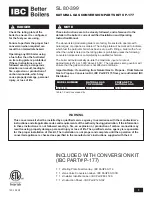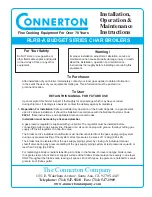
9
Response 80 / 100 / 120
- Installation
Ensure that the mains water supply pressure is adequate to
provide the required DHW flow rate.
Refer to Table 1 on page 3.
The central heating system should be installed and
commissioned in accordance with BS. 6798 and, in addition,
for smallbore and microbore systems BS. 5449.
The domestic hot water system should be in accordance with
BS. 5546 and BS. 6700.
Any soldered joints on potable water pipework MUST NOT be
made with solder containing lead.
Ancillary pipework not forming part of the useful heating
surface should be lagged to prevent heat loss and any
possible freezing - particularly where pipes run through roof
spaces or ventilated underfloor spaces.
Draining taps should be at least
1/2
" BSP nominal size and be
in accordance with BS 2879.
Maximum recommended system hydraulic losses are given in
the Table within Frame 5.
WATER TREATMENT
Antifreeze fluid, corrosion and scale inhibitor fluids suitable for
use with boilers having copper heat exchangers may be used
in the central heating system.
For further information contact either:
Fernox Manuf. Co. Ltd
or
G E Betz Ltd.,
Tandem House
Widnes
Marlowe Way
Cheshire
Croydon, Surry CRO 4XS
Tel. 0870 601 5000
Tel: 0151 424 5351
3
SEALED SYSTEM REQUIREMENTS - Central Heating
Note.
Response combination boilers are suitable for
fully pumped pressurised sealed systems only.
REQUIREMENTS
1. General
Any method of filling, refilling, topping up or flushing
sealed primary hot water circuits from the mains via a
temporary hose connection is only allowed if it complies
with Water Bye-law 14, which states:
" (1) No closed circuit shall be connected to a supply pipe.
(2) Paragraph (1) shall not apply to a temporary connection
provided that:
a. The connection is made through a double check valve
assembly or some other no less effective device which
is permanently connected to that circuit;
and
b. The temporary connection is removed after use. "
The method described in this instruction complies with
that Bye-law.
2. BS. Requirements
The installation must comply with the requirements of
BS. 6891:1988 and BS. 5449.
3. Flow Temperature
The installation should be designed to work with flow
temperatures of up to 90° C.
4. Working Pressure
All components of the system must be suitable for a
working pressure of 3 bar (45 lb/in
2
) and temperature of
110°C. Extra care should be taken in making all
connections so that the risk of leakage is minimised.
The following components are incorporated within the
appliance:
a.
Circulating pump.
b.
Safety valve; with a non-adjustable pre-set lift
pressure of 3 bar (45lb/in
2
).
c.
Pressure gauge; covering a range of 0-6 bar.
d.
8-litre expansion vessel; with an initial charge
pressure of 1 bar (15 lb/in
2
).
e.
Domestic hot water (DHW) mini expansion vessel.
For further details refer to BS.5449:1 and the British Gas
Corporation publication 'Specifications for Domestic
Central Heating and Hot Water'.
GENERAL
THERMOSTATIC RADIATOR VALVES (TRV)
Caradon Plumbing Limited recommend that heating systems
utilising full thermostatic radiator valve control of temperature
in individual rooms should also be fitted with a room
thermostat controlling the temperature in a space served by
radiators not fitted with such a valve as stated in BS. 5449.
When thermostatic radiator valves are used, the space
heating temperature control over a living area having a heating
requirement of at least 10% of the boiler heat output should be
achieved using a room thermostat whilst other rooms are
individually controlled by thermostatic radiator valves.
For further information refer to the 'Good Practice Guide 143', a
publication of the Energy Efficiency Office, available from the
Building Research Establishment, Garston, Watford WD2
7JR. Tel: 01923 664258.
ELECTRICAL SUPPLY
WARNING. This appliance must be efficiently earthed.
Wiring external to the appliance MUST be in accordance with
the current I.E.E. (BS.7671) Wiring Regulations and any local
regulations which apply.
The point of connection to the mains should be readily
accessible and adjacent to the boiler, except for bathroom
installations where the point of connection to the mains MUST
be situated outside of the bathroom.
Note.
Where a room sealed appliance is installed in a room
containing a bath or shower then the appliance and any
electrical switch or appliance control utilising mains electricity
should be so situated that it cannot be touched by a person
using the bath or shower.
Summary of Contents for responce 100
Page 1: ......
Page 62: ...62 Response 80 100 120 Installation NOTES ...










































